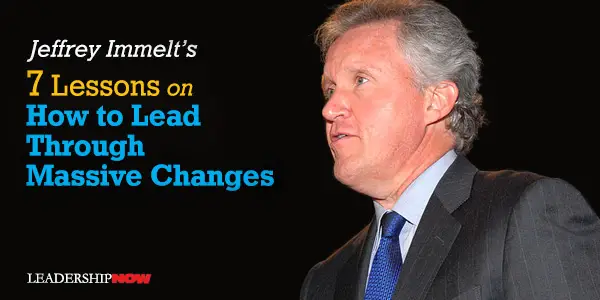 |
 |
09.04.17

Jeffrey Immelt's 7 Lessons on How to Lead Through Massive Changes
J In an article from the September–October 2017 issue of the Harvard Business Review, How I Remade GE, Jeffrey Immelt shares seven lessons he learned along the way. Lesson 1: Be disciplined and focused. "You need a point of view. Your initiatives should be interconnected—and it's the leader's job to connect the dots for everyone in the organization." A point of view can take you somewhere. It allows others to get on board and contribute in ways that support that point of view. As leaders, we must communicate how each part contributes to the whole. Change should be holistic. It creates focus and passion. Lesson 2: Be curious and reflective. "You have to go through a period of rewiring your brain—getting yourself to the point of profoundly believing that the world is changing and that the survival of your company depends on either anticipating the change or being in the vanguard of those reacting to it." To drive lasting change, you must be firmly anchored in what they believe. With most change, you can expect criticism. Today more than ever, the sources of resistance are more numerous and varied. Knowing your own values and beliefs are the source of courage you will need to weather any pushback. You have to see change as vital—life or death. And you are focused on your core beliefs and values and communicate them clearly, you are less likely to be distorted from the primary objective. Lesson Three: Get people to see the need for change as existential. "Every time we drove a big change, I treated it as if it were life or death. If you can instill that psychology in your management group, you can get transformation." Our world is never static. We are often confronted with the need for change or slow death. It's change or die. But it has to be communicated to the point to where what you as the leader have come to understand, is understood by everyone in the organization or to those you wish to see change happen. The goal is to give up control to allow the change to be internalized in them. Lesson Four: Be all in. "Half measures are death for big companies because people can smell lack of commitment. When you undertake a transformation, you should be prepared to go all the way to the end. You've got to be all in. You've got to be willing to plop down money and people." Where you focus your resources communicates a lot about what is important to you. Lesson Five: Be resilient. "I subscribe to the words of the great philosopher Mike Tyson, who said, ‘Everyone has a plan until they get punched in the mouth.' It is so difficult to predict events. It is difficult to sustain transformation during tough times, but it's the only way to create a better future." You need flexibility of action and resiliency of character. The kind of change Immelt is talking about here is not incremental change. It's deeper than that and you little control over outcomes. It means facing uncertainty and letting go of control and adapting to guide your organization to the primary objective. You have to take the long view. Nothing will turn out exactly the way you plan it. Lesson Six: Listen and act at the same time. "You need to allow new thoughts to constantly come in, and you need to be open to the reality that your organization will have to pivot when it learns something new, while still having the courage to push people forward." Leaders must listen to those they lead if only because they firmly believe that their welfare is the goal. It's a sign of respect. And respect builds trust. When change is built on the needs of those you lead, it becomes their change too. Lesson Seven: Embrace new kinds of talent, a new culture, and new ways of doing things. Leaders must become not merely leaders of followers, but leaders of leaders. Ultimately a leader has to love his or her followers as much as they love the change they want implemented. As leaders we are necessary, but alone, we are insufficient. To create an adaptable culture, you need adaptable leaders.
Posted by Michael McKinney at 12:13 AM
|
BUILD YOUR KNOWLEDGE
 

How to Do Your Start-Up Right STRAIGHT TALK FOR START-UPS 
Grow Your Leadership Skills NEW AND UPCOMING LEADERSHIP BOOKS 
Leadership Minute BITE-SIZE CONCEPTS YOU CAN CHEW ON 
Classic Leadership Books BOOKS TO READ BEFORE YOU LEAD |